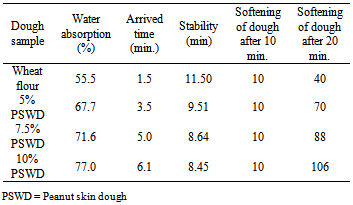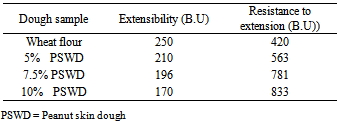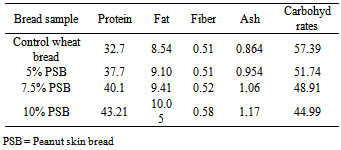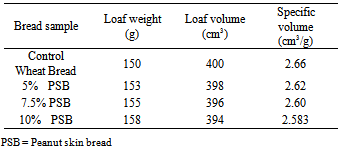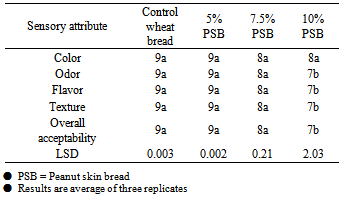-
Paper Information
- Next Paper
- Previous Paper
- Paper Submission
-
Journal Information
- About This Journal
- Editorial Board
- Current Issue
- Archive
- Author Guidelines
- Contact Us
Food and Public Health
p-ISSN: 2162-9412 e-ISSN: 2162-8440
2014; 4(2): 49-53
doi:10.5923/j.fph.20140402.05
Effect of Incorporation of Peanut Skin Flour to the Production of Wheat Bread
Abdel Moneim E. Sulieman1, Wisal A. M. Babiker2, Sirekhatim B. Elhardallou2, Elamin A. Elkhalifa3
1Department of Biology, Faculty of Science, University of Hail, Kingdom of Saudi Arabia
2Faculty of Applied Medical Sciences, University of Taif, Taif, Kingdom of Saudi Arabia
3Department of Food Science and Technology, Faculty of Engineering and Technology, University of Gezira, Sudan
Correspondence to: Abdel Moneim E. Sulieman, Department of Biology, Faculty of Science, University of Hail, Kingdom of Saudi Arabia.
| Email: |  |
Copyright © 2014 Scientific & Academic Publishing. All Rights Reserved.
This study aimed to find out the effect of incorporating the by-products peanut skin flour in bread formulation at 5%. 7.55 and 10% levels. The results show that peanut skin contained: 9.25%, 4.6%, 11.7%, 9.42% and 65.08% protein, fats, crude fibre, ash and carbohydrates, respectively. The analysis for rheological properties indicates that the addition of various levels of peanut skin to wheat flour caused an increase in arrived time and a decrease in dough stability. Maximum resistance to extension was found to be increased from 420 for wheat flour alone to 634 millimeters for wheat flour containing 5% peanut skin powder, while increasing the addition of peanut skin to 7.5%, 10% caused a increase in dough resistance to (B.U extension to 851 and 957 B.U, respectively. The bread samples prepared by adding peanut skin flours have lead to increase in the water absorption while the arrival time and dough stability were decreased. Addition of peanut skin flour to the bread baking has resulted in production of highly nutritious bread which has been highly accepted by the human panelists. So, nutritional fibre as a food industry by product is recommended to be used as food additives to gain nutritional and healthy benefit.
Keywords: Chemical composition, Water absorption, Panelist, Texture, Extensibility
Cite this paper: Abdel Moneim E. Sulieman, Wisal A. M. Babiker, Sirekhatim B. Elhardallou, Elamin A. Elkhalifa, Effect of Incorporation of Peanut Skin Flour to the Production of Wheat Bread, Food and Public Health, Vol. 4 No. 2, 2014, pp. 49-53. doi: 10.5923/j.fph.20140402.05.
Article Outline
1. Introduction
- Dietary fibre is now defined as food material, particularly plant material, that is not hydrolysed by enzymes secreted by the human digestive tract but that may be digested by microflora in the gut. Plant components that fall within this definition include non-starch polysaccharides (NSP) such as celluloses, some hemi-celluloses, gums and pectins, as well as lignin, resistant dextrins and resistant starches [1].Sources of dietary fibre include vegetables, wheat and most other grains. Foods rich in soluble fibre include fruits, oats, barley and beans. The nutritional and health benefits of DF continue to be the subject of much study and have been reviewed by many authors, including O’Sullivan [2] and WHO/FAO [3].Dietary fiber intake provides many health benefits. A generous intake of dietary fiber reduces risk for developing the following diseases: coronary heart disease, stroke, hypertension, diabetes, obesity, and certain gastrointestinal disorders [4][5][6]. In addition, increased consumption of dietary fiber improves serum lipid concentrations, lowers blood pressure, improves blood glucose control in diabetes, promotes regularity, aids in weight loss, and improves immune function [7][8][9] [10].High fibre foods, because of their consistency, encourage mastication and stimulate the secretion of digestive juices. The soluble components of DF cause an increase in the viscosity of the stomach contents, thereby retarding gastric emptying [11]. This then affects the rate of digestion and the uptake of nutrients and creates a feeling of satiety.Peanut is one of the nuts cultivated on a large scale in the world. It is considered one of two or three most important oil crops attaining an annual production of more than 19 million tons. Also, peanuts are the third most important source of vegetable protein providing 11% of the total world supply. Peanut skin, which constitutes about 3% of the seed weight, is a by-product of the processing of peanut for human consumption. It has a bitter taste and can only be used in small quantities in ruminant feeds [12]. The skin could provide an inexpensive source of natural antioxidants, such as catechins and procyanidin, for use in food and dietary supplements. Also it contains higher concentration of procyanidin trimers and tetramers than grape seed which gives peanut skin a comparative advantage as a source of potent antioxidants [13]. The present study aimed to investigate the effect of incorporation various levels of the food industry by-products, peanut skin on the bread making and evaluation of the product.
2. Materials and Methods
2.1. Materials
- The food industry by-product peanut seed skin peels (Arachis hypogaea L) were brought from the local market during April 2010. The Peels were well washed and dried at 63˚C using a fan oven. They were then ground into fine powder using a laboratory mill. The ingredients which were used in bread making were also bought from local market. These ingredients included: wheat flour (72% extraction rate), compressed baker's yeast, sucrose, salt and shortening.
2.2. Peanut Skin Flour Analysis Methods
2.2.1. Chemical Composition
- The chemical composition of the different samples was determined. These analyses included determination of the contents of moisture, protein, ash and crude fibre using AOAC [14] methods. For determination of moisture content, ventilated air oven until constant weight under temperature (120˚C for 2 hour. Moisture content was then calculated as a percentage from the original weight. For protein determination, the total nitrogen was determined using Micro Kjeldah method. Crude protein calculated as total nitrogen × 6.25.The fat contents were determined using AOAC [15] method in which Soxhlet apparatus was used and hexane was the extraction solvent, the extraction continued for 6 hours, then the fat content was calculated. The carbohydrates content was determined by difference as follows:-Carbohydrate %=100 – (moisture % + protein % + ash % + fat % + crude fiber).
2.2.2. Minerals Content
- The contents of iron, copper, zinc and lead were determined by using Atomic Absorption Spectrophotometer (PYE Unican 929) according to the method of AOAC [16]; in which each sample was ashed in a muffle furnace at 525℃ for 6 hours until white or light grey ash was formed. The ash was dissolved in 0.1 N HCL and diluted to 50 ml. Then the concentration of mineral sample was determined using standard curve.
2.3. Dough Analysis Methods
2.3.1. Farinograph Test
- Water absorption (amount of water required for the dough to have consistency of 500 Brabender units line), arrival time (the time in minutes required for the curve to reach the 500 Brabender unit line after the mixer will be started and water will be added, mixing time (the time in minutes from the first addition of the water to development of dough's maximum consistency), stability (the time in minutes elapsing when the top of the curve interacts first 500 B.U. line leaves that line) and softening of wheat flour dough and its blends with peanut skin were determined according to AACC [17] methods using a Farinograph type (PL) (Barbender Farinograph, Germany). 300 grams of tested samples (14% moisture basis) were used.
2.3.2. Extensograph Test
- Extensograph test was carried out according to the method described by AACC (1987) [17] to measure the following data: dough extensibility (E) (the total length of the base of the Extensogram measured in millimeters), dough resistance to extension (R) (the height of the Extensograph curve was measured in Brabender units after 5 minutes from the start, dough energy (represented by the area in Cm2 out lined the curve) and the peak height (the maximum height of the Extensograph curve measured in Brabender units).
2.4. Bread Analysis Methods
2.4.1. Bread Making
- Bread was made using the 100 - g straight dough method. The basic formula included 100g of flour, 2g of compressed baker's yeast 1g of sucrose, 2g of salt, 1g of shortening (cottonseed vegetable oils manufactured by Nile company, Sudan), water as needed, and different concentrations of peanut skin flour, which has been added at 5, 7.5 and 10% concentration on a flour replacement basis. After mixing the dough was allowed to rest for ten min at room temperature, then scaled to three portions for 120g each, molded into round balls and allow rest for another 10 min. Then put in pans and transferred into the fermentation cabinet. The dough was fermented for 60 min. at 30°C followed proof period for 15 min. The fermentation dough's were then baked in Simon Rotary baking oven at 250°C for 15 min.
2.4.2. Bread Quality Parameters
- The average weight of loaves was recorded after cooling the loaves. The loaf volume was measured by rapeseed displacement method according to AACC [17] method. And the specific volume (cm3/g) was calculated by dividing volume of the loaf by its weight.
2.4.3. Sensory Evaluation
- Control bread sample and bread containing various amounts of peanut skin flours were coded and served to panelists (20 members) to rank them using a 10-point rating scale where 9-10 = excellent, 7-8 = good, 5-6 = satisfactory, 3-4 = poor and 1-2 = very poor for each attribute. Samples were evaluated for appearance, color, texture, odor, taste and acceptability.
2.5. Statistical Analysis of Data
- Data were statistically analyzed using computerized program Scientific Computer Center, Faculty of Home Economics, Minufyia University, using Duncan Multiple Range Test (one way ANOVA test) according to (Amitage and Berry [18].
3. Results and Discussion
3.1. Chemical Composition
- The chemical composition of wheat flour and peanut skin samples is shown in Table (1). From the results presented in Table (1) it could be noticed that the wheat flour (72% extraction) contained, 13.19%, 1.24%, 0.56%, 0.68% and 84.34% protein, lipids, fiber, ash and carbohydrates respectively. While the peanut skin contained 9.25%, 4.6%, 11.7%, 9.42% and 65.08% protein, lipids, fiber, ash and carbohydrates, respectively. These results confirmed those obtained by (El- badrawy [19] who found that wheat flour contained 84.35% carbohydrates, 13.11% protein, 1.51% fats and 0.42 fiber. The results were not far from those of Block et al., [20] who found that peanut skin contains 10.5% protein, and 5.0% ash.
|
3.2. Dough Characteristics
- The results presented in Table (2) show the effect of addition of peanut skin to wheat flour on Farinograph readings. The addition of various levels of peanut skin to wheat flour caused an increase in arrived time and a decrease in dough stability. Arrival time was 1.50, 3.5, 5.0 and 6.1 min, while the dough stability was 11.5, 9.51, 8.64 and 8.45 min at the levels 0, 5%, 7.5% and 10%, respectively. Softening of dough after 20 min found to be 40, 70, 88 and 106, while after 10 min was 10 at different levels.
|
|
3.3. Chemical Composition of Bread
- The protein, fats, crude fibre, ash and carbohydrates, were determined for the control bread (100% wheat flour) and the bread supplemented with different levels of penut skin is indicated in Table (4). I could be noticed that supplementation of bread with orange peels associated with the increasing of protein, lipids, fiber and ash than that of bread without supplementation. These increases in protein, fats, crude fibre and ash may be due to relative increase of these nutrients in penut skin.
|
3.4. Bread Quality Parameters
- The results presented in Table (5) show the effect of addition of replacement of peanut skin at 5%, 7.5% and 10% levels to wheat flour on the baking characteristics of bread. Loaf bread weight increased with increasing peanut skin concentration. It increased from 150 for wheat flour (72% extraction) to 153, 155 and 158 g at the levels 0%, 5%, 7.5% and 10%. This weight enrichment was due to the high water retention of high fiber material content of peanut skin. Loaf bread volume and specific volume decreased by increasing peanut skin addition. Loaf bread volume decreased from 400 cm, at control sample to 398,396 and 394 cm. with 5%, 7.5% and 10% respectively. These decreases may be due to the dilution of gluten [22], and high fiber content of peanut skin. Specific volume of bread decreased from 2.66 cm/g in control sample to 2.62, 2.60, 2.583 cm/g. with 5%, 7.5% and 10% addition of peanut skin, respectively. From the results, it could be concluded that fiber of peanut skin have a real weakness effects on dough blends, attributed to the dilution of gluten by fibers. Same conclusion was found by (Sharaf et al., [23] for wheat bran fibre.
|
3.5. Sensory Evaluation
- The results of the sensory evaluation of various bread samples are presented in Table (6). All bread samples (control and supplemented) were highly accepted by the panelists. The sensory attributes of control wheat bread samples were insignificantly different (P < 0.05) from those of wheat bread supplemented with 5% and 7.5% peanut skin flour. The statistical analysis indicated significant decreases (P<0.05) of all sensory attributes of bread supplemented with 10% peanut skin flour. The decreases in appearance scores with higher replacement levels of peanut skin flour could be attributed to the panelists who usually prefer white than the darker grades. However, all the sensory attributes of bread supplemented with levels of 7.5% and 10 % for peanut skin flour were significantly decreased (P<0.05) compared to control.
|
4. Conclusions
- Addition of peanut skin flour to the bread baking has resulted in production of highly nutritious bread. However, all bread samples (control wheat bread and wheat bread supplemented with various levels of peanut skin flour) were highly accepted by the panelists who gave high scores of most of the sensory attributes, however, the highest scores were given to bread samples supplemented with low levels of peanut skin flour (5%). Generally, the poor baking quality of bread supplemented with high levels of peanut skin flour can partly explained by the dilution of the functional gluten proteins and/or the interaction between fibrous materials and gluten. Nutritional education programs about the importance of food industry wastes such as peanut skin for health must be conducted at all culture media. Further studies are needed to investigate the effects of these wastes and their products on chronic disease.
ACKNOWLEDGEMENTS
- The authors express their gratitude and thanks to all who helped the execution of this work especially the staff member of the Department of Food Science and Technology Faculty of Engineering and Technology, Gezira University, Sudan.
 Abstract
Abstract Reference
Reference Full-Text PDF
Full-Text PDF Full-text HTML
Full-text HTML
